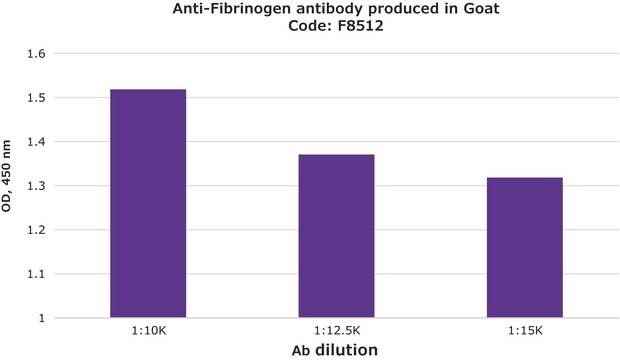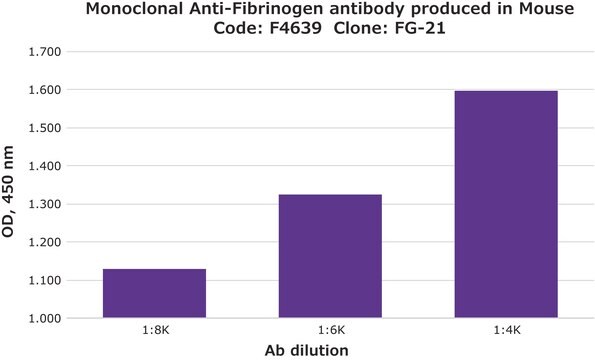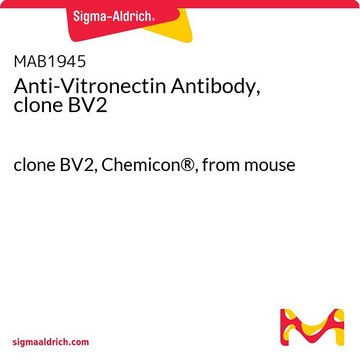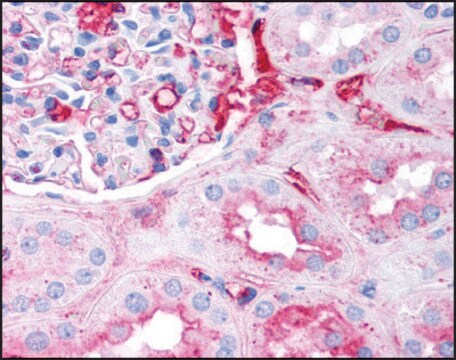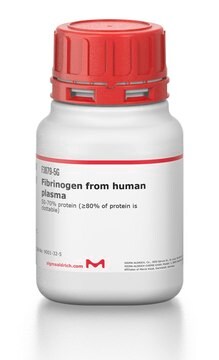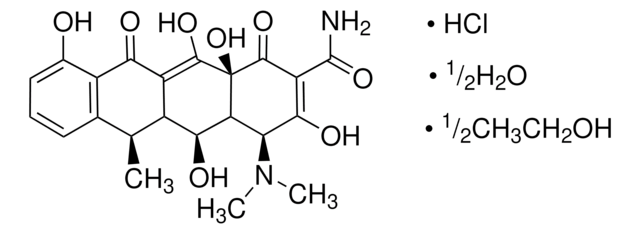General description
Fibrinogen is a blood coagulation protein that consists of Aα, Bβ and γ polypeptide chains. Fibrinogen expression is induced by acute-inflammatory responses and has also been associated with the risk of cardiovascular disorders. Monoclonal Anti-Fibrinogen antibody recognizes a conformational epitope, which is destroyed by the cleavage of the γ (302-303) bond. This epitope is found in fibrinogen and in fibrin monomers (devoid of either fibrinopeptide A, or both A and B fibrinopeptides), when they are immobilized on ELISA plates. The antibody reacts with the D-dimer and D-fragment. It does not recognize individual fibrinogen/fibrin chains in denatured-reduced forms or their proteolytic fragments. The E fragment is not recognized by the antibody. The antibody reacts with greater avidity with protofibrils than with wider fibrin fibers in electron microscopic analysis. Monoclonal Anti-Fibrinogen is specific for fibrinogen and fibrin in humans, baboons, bovines, sheep, goats, pigs, rabbits and dogs.
Fibrinogen was the first blood coagulation factor to be identified, and it is a precursor of fibrin protein. The three polypeptide chains are coded by three genes located on human chromosome 4q23-q32, and spans 51kb.
Specificity
The product recognizes a conformational epitope, which is destroyed by the cleavage of the γ (302-303) bond. This epitope is found in both fibrinogen and in fibrin monomers, devoid of either fibrinopeptide A, or both A and B fibrinopeptides, when they are immobilized on ELISA plates. The antibody reacts with the D-dimer and D-fragment. It does not recognize individual fibrinogen/fibrin chains in the denatured-reduced form and their proteolytic fragments. The E fragment is not recognized by the antibody. Using electron microscopy, the antibody reacts with greater avidity with protofibrils than with wider fibrin fibers.
Immunogen
human fibrin degradation products
Application
Applications in which this antibody has been used successfully, and the associated peer-reviewed papers, are given below.
Immunofluorescence (1 paper)Monoclonal Anti-Fibrinogen antibody is suitable for use in indirect ELISA, dot blot (1:1000 using human fibrinogen), and western blot.
Monoclonal Anti-Fibrinogen antibody produced in mouse has been used in immunohistochemistry and confocal laser scanning microscopy.
Biochem/physiol Actions
Fibrinogen is an acute-phase inflammatory protein, which plays an essential role in blood clotting.
Disclaimer
Unless otherwise stated in our catalog or other company documentation accompanying the product(s), our products are intended for research use only and are not to be used for any other purpose, which includes but is not limited to, unauthorized commercial uses, in vitro diagnostic uses, ex vivo or in vivo therapeutic uses or any type of consumption or application to humans or animals.
